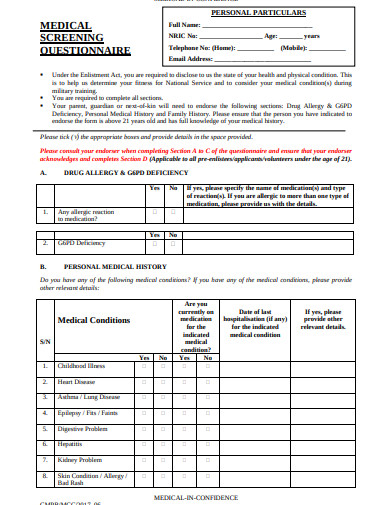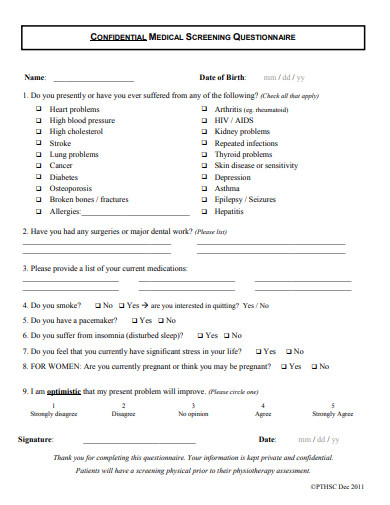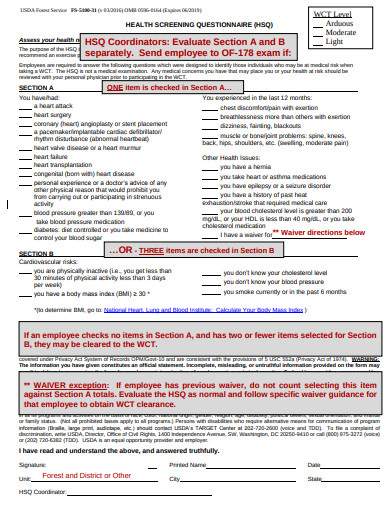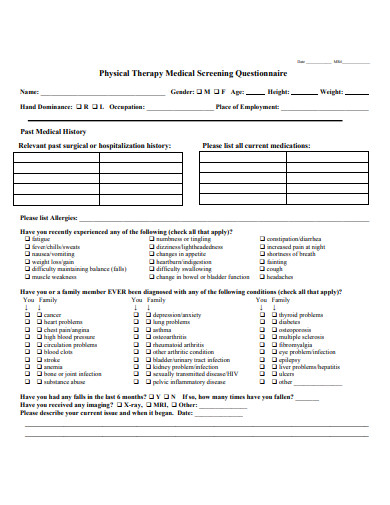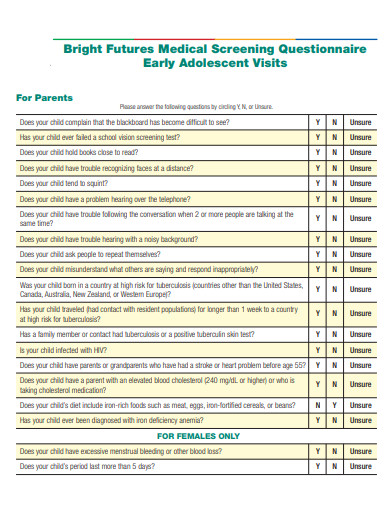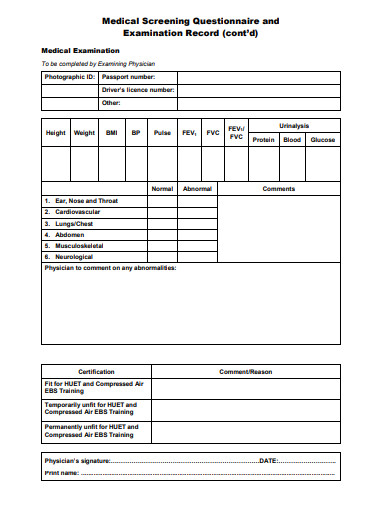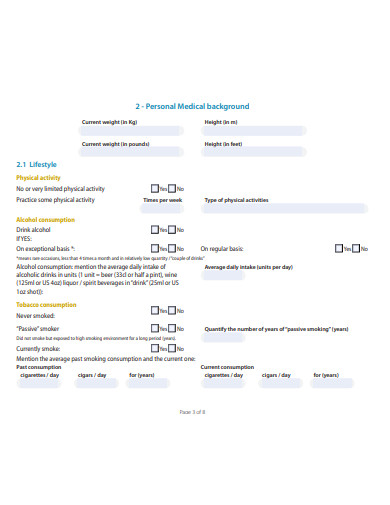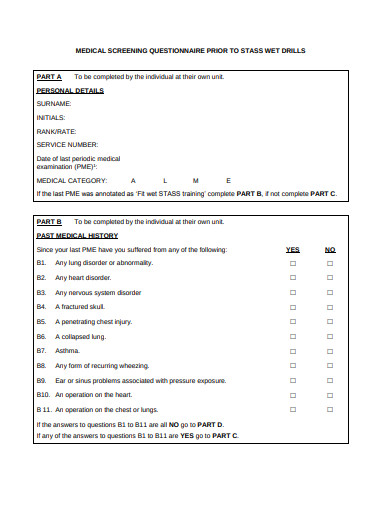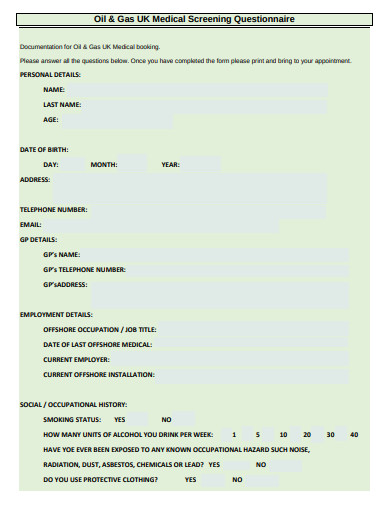10+ Medical Screening Questionnaire Examples to Download
A new strain of coronavirus, 2019-nCoV, has the world worried about its probability of becoming a global pandemic. Early detection of the virus in patients is challenging because the symptoms of the infection don’t manifest until much later. Because the infection can also be asymptomatic, seemingly healthy people may be carriers. Visiting new places and large crowds is discouraged for people in affected areas as it runs the risk of spreading the virus. Medical screening on the onset of signs and symptoms of the infection is key in containing the virus and preventing an outbreak.
Medical screening is generally employed in hospitals and clinics as an overall assessment of an individual’s health and physique. It involves running the clinical profile of a person with a known standard of health through physical examination and laboratory tests. This is especially useful for jobs that require intensive physical activity. Aside from a job requirement to test of fitness for employment, medical screening is a routine for everyone to monitor personal and public health. In epidemiological cases, it is a preventive measure administered in areas where foreign disease-causing pathogens may enter the local scene through a human host, like in airports and seaports.
Medical health screening is a cautionary step done on a widescale to identify people who are showing symptoms of disease and infection. The person will then undergo confirmatory tests for verification. Whereas, a diagnostic test is done on the person who displayed symptoms of illness or infection after screening. The purpose of diagnosis is to find out the cause of the symptoms and recommend treatment.
Benefit of Questionnaires
For standardized and systematic medical screening operations, medical personnel use questionnaires where they can tick boxes for information and note additional details in the comment section. This screening tool allows for a uniform assessment of the people’s health based on what to look for, as indicated in the form. Therefore, you need to have an upgraded medical screening form that takes into consideration all possible conditions that will help in disease detection.
Questionnaires are easy to use and cost-effective, as well. They are simple documents, but when prepared right, they are very helpful in detecting the early progress of diseases. The form is straightforward, practical, and easy to reproduce for widescale use. The data obtained from these forms can be compiled into a system for distribution with concerned authorities and institutions. Medical personnel and researchers can also refer to these records for further studies, as well as be resources for medical case studies.
Medical Screening Drawback
Although medical health screening helps in detecting the early manifestation of diseases and help prevent outbreaks, it has its downside. The symptom can be true for most health cases that diseases can have overlapping signs. For example, fever is the body’s physiological response to an infection to kill the harmful pathogen through a rise in body temperature. Therefore, a fever will not tell medical professionals what kind of infection the person has. The patient will have to undergo diagnostic tests to have a definite identification of the condition and be recommended with medical intervention.
Another case against medical screening is that certain contagious illnesses can’t be detected early on. This case is unfortunately true for the 2019-nCoV outbreak. Infection from the coronavirus family affects the respiratory tract. Therefore, the illness would manifest in the form of respiratory conditions from mild cold and cough to pneumonia and bronchitis. The virus is airborne and can also be transmitted through physical contact with an infected person or object. Preventing the virus from spreading is difficult because viral transmission for this strain occurs when the infected person doesn’t exhibit symptoms of the infection yet. How can one apprehend something when you don’t know if it is there?
10+ Medical Screening Questionnaire Examples
Browse through the following samples of medical screening templates that you may take inspiration from.
1. Medical Screening Questionnaire Form
2. Medical Screening Questionnaire Example
3. Confidential Medical Screening Questionnaire
4. Medical Health Screening Questionnaire
5. Physical Therapy Medical Screening Questionnaire
6. Diving Medical Screening Questionnaire
7. Medical Screening Questionnaire Checklist
8. Medical Screening Questionnaire and Examination Record Form
9. Pre Screening Medical Questionnaire Checklist
10. Staff Medical Screening Questionnaire
11. Oil and Gas Medical Screening Questionnaire Form
How To Prepare Medical Questionnaires
When you are the one preparing a medical screening questionnaire, you should keep in mind that your product will be a cardinal element in preventing diseases and illnesses from becoming a pandemic. The burden you carry in this task is gargantuan. Let the following reminders lighten the load for you.
1. Keep It Simple And Complete
Medical screening questionnaires are like evaluation forms that will help detect early onset of diseases to prevent their spread. Skip the doodles and focus on including a comprehensive list of signs and symptoms, as well as other medical conditions, that are common in the population. Indication of conditions, like diabetes and high blood pressure, in patient medical profile will inform physicans that certain medical intervention aren’t applicable to the patient. The questionnaire should cover an overall health assessment of the patient so that proper intervention and treatment will be given.
2. Skip Unnecessary Jargon
Unless the questionnaires are strictly for the use of medical professionals, use terminologies that are easily understood by the mass. For example, people are likely to understand the word urination more than they would its medical term micturition. Although it is common knowledge in the medical community, it is better to skip the jargon for something that is common knowledge. Remember, the patients may be the ones filling out the forms. Keep the language layman-friendly.
3. Use Reader-Friendly Format
Patient consultation may not always occur in a well-lit room, and the attending medical personnel or the patient may not be at the best condition to traverse the labyrinth that is your complicated questionnaire. Therefore, use white paper and black ink to create as much contrast as possible for easy reading. Make sure the important terms are in bold and the text are well-spaced. If the text and the tick box is not immediately next to each other, use a table format for easy navigation. Always think of the possible settings in which the form will be filled in and make sure that task is indeed possible.
4. Compartmentalize Information
Group related information together for easy tracking. You can include general symptoms like fever, coughing, and colds together, and put the hereditary diseases on another subsection. This will keep your form organized and easy to follow. It also helps the attending medical professional track the medical condition of the patient.
Medical screening is not a perfect catch-all measure for preventing outbreaks and a global pandemic. It has its weaknesses. Despite its problems, health screening is still efficient in slowing down the spread of the disease in time for scientists and researchers to come up with treatment and intervention. And clinical profiling of the disease and patients using medical questionnaires are key to this degree of success.



